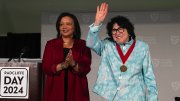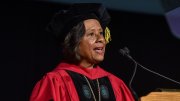As a child, Justice Sonia Sotomayor loved watching the television show Perry Mason. From the living room of her Bronx public housing apartment, the future Supreme Court associate justice was enraptured by the lead fictional lawyer. “In the first half of the show, he investigated the crime,” recalls Sotomayor. “In the second half, he proved his client innocent. What a great combination!” Mason taught the young Sotomayor that being a lawyer “was a way to help people.”
The world, she quickly discovered, is not as neatly scripted as that legal drama. She soon found some more realistic role models: Southern judges who upheld and followed Brown v. Board of Education’s racial protections despite being raised with segregation and having no personal commitment to desegregation. “These men broke with their cultures, subjected themselves to threats to their life,” she said. “They were brave men who believed in the power of law to form that more perfect union.”
Friday afternoon, the Radcliffe Institute honored Sotomayor with the Radcliffe Medal for her judicial and civic impact. She spoke alongside 300th Anniversary University Professor Martha Minow and was introduced by actress Rita Moreno. She is the third Supreme Court Justice to receive the Radcliffe Medal, following Sandra Day O’Connor (2009) and Ruth Bader Ginsburg (2015).
Early in her career, Sotomayor pursued good through prosecution. After completing her undergraduate studies at Princeton University and her J.D. at Yale Law School, she spent five years as an assistant district attorney in Manhattan. There, she sought to repair—through sentencing, and through deep care for the people involved in the crimes she judged. Moreno, who narrated Sotomayor’s 2013 memoir My Beloved World, recalled a child pornography case Sotomayor prosecuted. In reviewing the harrowing video evidence, Sotomayor picked out the small details—like the child’s bare feet on the floor—to make the crime feel like more than just a statistic. Moreno describes the Justice as “a prosecutor who, despite the professional detachment her job often required, could not detach herself from the magnitude of the victims who she sought to protect.”
That empathy extended to alleged criminals, too. Save two defendants whom she characterized as “pure evil,” she said that every defendant she encountered “had some circle of people who loved them and they were good to,” adding, “and I always tried to see what that [good] might be.”
Sotomayor describes herself as an optimist and said that her judicial style reflects her belief in humanity. A liberal justice on a conservative-leaning court, she has written many dissents during her fifteen years on the highest bench. In her opinions, especially the dissents, she writes to the people who could help improve the law in the future. Sometimes, she challenges lower courts to “think more broadly.” Other times, she writes to Congress, saying “I think these guys got it wrong. You should fix this.” Often, she says, “I’m writing to the public,” to remind them “of their power to change law.”
But for the public to change the law, they must understand how. Sotomayor worries about the state of American civics education. When STEM started to take over schools, she says, civics was often the first subject to be removed to make space. “We invest five cents in civics and fifty dollars in STEM,” she said. She helps lead iCivics, an online, game-based civics education nonprofit that Justice O’Connor founded in 2009. She hopes that reinvigorating political education can both help cool partisan tensions and create a new generation of successful, politically-engaged citizens. “Civic education is critical,” she says, “not only to maintain our democracy but also [to inspire] our young people to defend it.”
Understanding the processes that govern the nation can help students respectfully engage with a wider range of beliefs. For example, her disagreements with her fellow Justices—of which, she joked, there are many—do not preclude friendly relations. “Disagreeing about ideas doesn’t make another human being evil or bad.”
Disagreement, she continued, is very hard. “There are days that I’ve come to my office after an announcement of a case and closed my door and cried. There are moments that even I feel desperation. You have to shed the tears,” she said, “and then you have to wipe them and get up and fight some more.”
In those fights, she is heartened by her belief that the law bends toward good. She spoke of Dred Scott, a slave whom the Supreme Court denied freedom in a landmark case. At the end of his life, Scott said he would not have pursued the case if he were to do it again. “My heart broke,” she said, “because I wish he could have known what happened in the arc of the universe.” After much fighting, racial equality became enshrined in the law. “Throughout our history,” she continued, “men and women have given up their lives to secure our freedom and to promote our equality. There is no one in this room who is entitled to give up now. If others gave their lives…we must devote our lives.”
Radcliffe Dean Tomiko Brown-Nagin concluded the event by presenting Sotomayor with the Radcliffe Medal, which reads:
She is a fair-minded arbiter, who has demonstrated a fierce commitment to the ideals of due process and equal protection under the law. She is a discerning jurist, who never fails to recognize the human impact of legal decisions. She is a role model for civic engagement, who with each ringing dissent signals that we are neither powerless nor exempt from the responsibility of shaping a more fair and just society.









